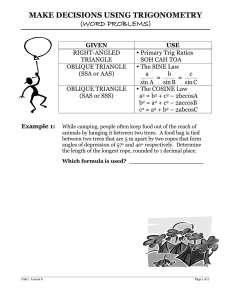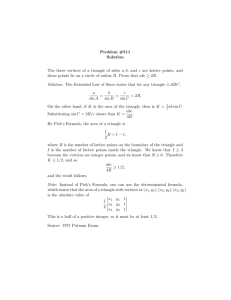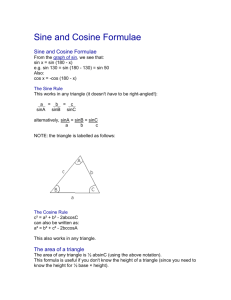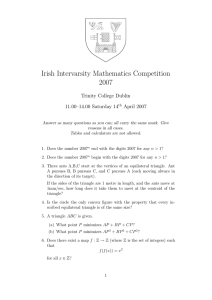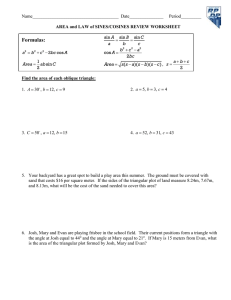Problem Sectlon Editor
advertisement
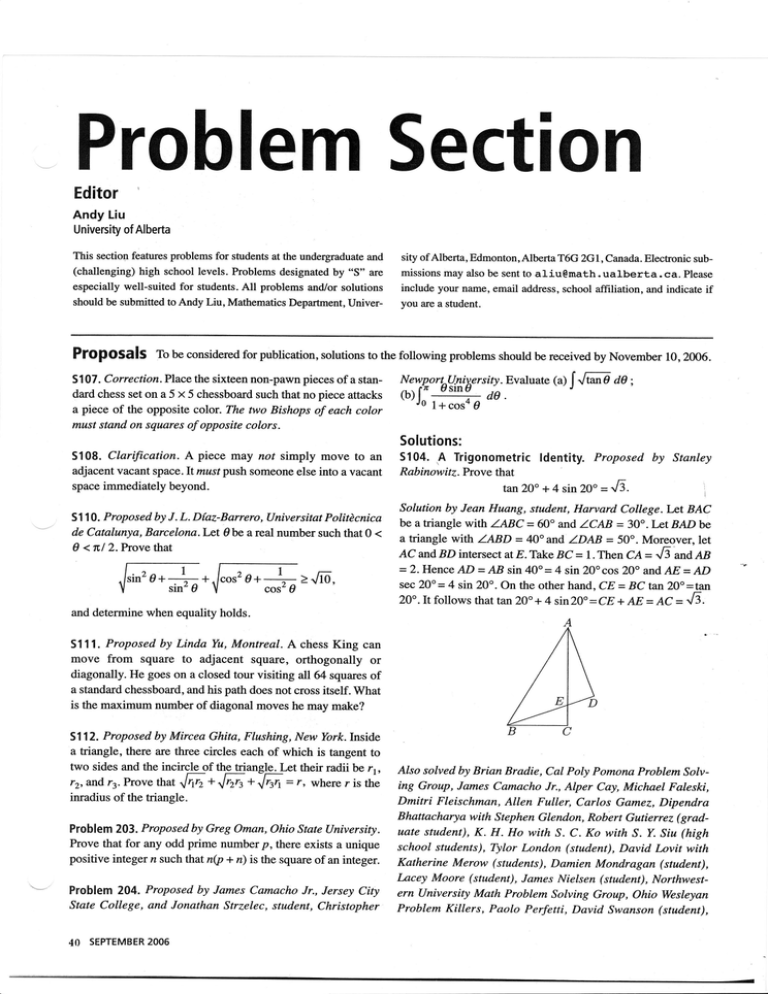
Problem Sectlon Editor Andy Liu University ofAlberta This sertion featuresproblemsfor studentsat the undergraduate and (challenging)high schoollevels.Problemsdesignatedby "S" are especially well-suited for students.All problems and/or solutions shouldbe submittedto Andy Liu, MathematicsDepartnrent,Univer- PfOpOSalS sity of Alberta, Edmonton, Alberta T6G 2G1, Canada.Electronic submissionsmay also be sentto aliu€math. ualberta. ca. Please include your name, email address, school affiliation, and indicate if you are a sfudent. To be consideredfor publication,solutionsto thefollowing problemsshouldbe receivedby November10,2006. 5107 . Correction.Place the sixteen non-pawn pieces of a standard chess set on a 5 x 5 chessboard such that no piece attacks a piece of the opposite color. The two Bishops of each color must stand on sqwtres of opposite col.ors. @)[Jt*'e ae; !:*fl-b(X1ersity.Evatuat" --------------. tD)Jo | l + cos* 0 d0 Solutions: 5108. Clarification. A piece may not simply move to an adjacentvacant space.Itmusl push someoneelse into a vacant space immediately beyond. 5110. Proposed by J. L. Diaz-Barrero, Universitat Politicnica de Catalunya, Barcelona.l-et ebe a real number such that 0 < 0 <nl2. Provethat sin2o+-4-+ sin'0 coszo 5104. A Trigonometric ldentity. Proposed by Stanley Rabinowitz. Prove that tan20" + 4si n20" -^13. Solution by Jean Huang, student, Harvard College.I-et BAC be a triangle with./.ABC = 60o and ZCAB = 30o. Let BADbe a triangle with IABD = 40" and ZDAB = 50o. Moreover, let AC andBD intersectat4.TakeBC = l.Then CA=.13 andAB = 2.Hence AD = AB sin 40"= 4 sin 20"cos 20" arrdAE = AD sec 20"= 4 sin 20o. On the other hand. CE = BC 1u1/Qo=tan 20'. It follows that tan 20" + 4 sin20o=CE + An - AC = 43. and determine when equality holds. 5111. Proposed by Linda Yu, Montreal. A chess King can move from square to adjacent square, orthogonally or diagonally. He goes on a closed tour visiting all 64 squares of a standard chessboard, and his path does not cross itself. What is the maximum number of diagonal moves he may make? 5112. Proposed by Mircea Ghita, Flushing, New York.lnside a triangle, there are three circles each of which is tangent to two sides and the incircle of the triangle. Let their radii be rr, rr, andrr. Prove nat t!r1r, + ,[rrr, *-,trta = /, where r is the inradius of the triangle. Problem lQJ. Proposedby Greg Oman, Ohio State University. Prove that for any odd prime numberp, there exists a unique positive integer n such that n(p + n) is the square ofan integer. Probfem 204. Proposed by James Camacho Jr., Jersey City State College, and Jonathan Strzelec, student, Christopher .IO SEPTEMBER 2006 Also solved by Brian Bradie, CaI Poly Pomona Problem Solving Group, James Camacho Jr., Alper Cay, Michael Faleski, Dmitri Fleischman, Allen Fuller, Carlos Gamez, Dipendra Bhattacharya with Stephen Glendon, Rob,ertGutierrez (graduate student), K. H. Ho with s. C. Ko with s. y. siu (high school students), Tylor London (student), David Invit with Katherine Merow (students), Damien Mondragan (student), Incey Moore (student), James Nielsen (student), Northwestern University Math Problem Solving Group, Ohio Wesleyan Problem Killers, Paolo Perfetti, David Swanson (student),
![Math 131 Practice Exam 3 on [ -1, 4].](http://s2.studylib.net/store/data/010538103_1-a851ef52d08f89241a99ddd9d94bbb2a-300x300.png)
